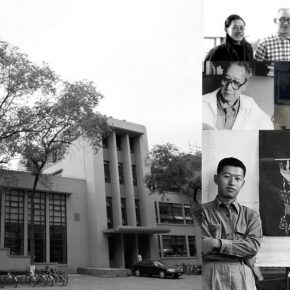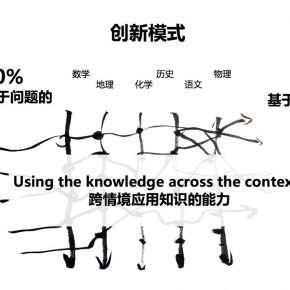
In the International Symposium of “Chinese Design 40 Years – Experiences and Models”, Prof. Lou Yongqi, Dean, College of Design and Innovation, Tongji University, presented a lecture entitled “Beyond Bauhaus, A Glance at Design Education of Tongji University”, and he shared some insights that led to many discussions. Lou Yongqi was interviewed by CAFA ART INFO, and shared his personal comprehension of the meaning of the Chinese Design 40 Years, and the positioning of the experiences in a historical context, he then further interpreted some related design cases at the seminar. For example, he interpreted the idea of Tongji-Huangpu School of Design and Innovation which is the first school based on the “design-driven innovation education” in China. He was the founder and head of the journal of “sheji”, and he then elaborated on the relationships and differences between the Chinese “sheji” and design, and in the end he predicted that it was going to create a breakthrough in the model of the design industry in the future. Lou Yongqi’s extremely forward-thinking ideas and execution capabilities which provided us with another perspective on design. These reflections and practices might reflect the experiences and practices of the Chinese designers who are actively facing the future.
Interview Date: March 21, 2018
Location: CAFA Art Museum Café
Interviewer and copywriter: Zhang Yizhi
Photo: Hu Sichen
Translated by Chen Peihua and edited by Sue/CAFA ART INFO
CAFA ART INFO: What do you think of the symposium of “Chinese Design 40 Years – Experiences and Models”? Would you like to share with us your original intention in attending this symposium?Lou Yongqi: Chinese designers have never created a model of experiences. We talked about the forty years of Chinese design, but it is a fact that people artificially decided on time. The division of time is actually man-made, and it forms a system. The system itself is also a subjective concept, and people decide the elements which can be summarized and examined, as well as the relationships between elements that are also created by people. The system always includes the big system, the middle system, and the small system. In other words, each school or institution has its own stories. Some people might summarize the 20-year experiences, and some people might summarize 100-year experiences, we place the 40 years in the context of China’s reform and opening up to examine design, and I cannot agree with it more. It is meaningful for me to participate in the discussion of Chinese Design 40 Years, because China has greatly changed in the past 40 years, when a small system was placed on the changes of a big system, a big world, it makes sense.
CAFA ART INFO: In the conference, you said that Tongji Huangpu School of Design and Innovation was the first public school of “design-driven innovation education” in China and was established in 2017. It uses a system composed of 60% of the courses that are basic courses and 40% of the courses are innovative courses. It is the first time to introduce the extended and research-based courses which are based on the “design-oriented thinking” in the middle school in China, and it must be difficult to practice. What do you think is the core of this model? Do you think this new education model of the School of Design and Innovation greatly influences the country?Lou Yongqi: It is at least a new paradigm. All the things including philosophical thoughts, the specific curriculum arrangements, and the relationships are established during the teaching process, as well as the development of the students’ personality etc., are all new paradigms. If it succeeds, this paradigm itself proves to be practicable. In other words, it offers a special path within the existing mainstream middle schools, so that, some children can find a new path outside the original system which they do not adapt to.
We believe that it is a lesser success to make our entire education system more inclusive and fit the different characteristics of children. The highest success is to make it a mainstream model, because it is possible that the mainstream and non-mainstream can be mutually transformed. This type of education will become a mainstream paradigm in the future, within a certain time. I believe that it is right for us to have some trials in the context of the fixed mainstream system. When we experiment, there will be new possibilities, regardless of whether it will become the mainstream secondary education model in the future.
CAFA ART INFO: What problem is questioned most?Lou Yongqi: Design has raised questions by many people. It is a crucial problem that students have to get good scores in the college entrance examination from the public perspective. Because the courses and textbooks that we have arranged and published are not perfect, we have to try, making progress by experimenting, repeatedly revising the textbooks, adjusting the styles of teaching, the evaluation system and the incentive system that is based on feedback. The program is developed step by step along with the running of the school. The result will tell us whether the school is successful or not, after the first group of students participate in the college entrance examination after three years. This education model will begin to be fully systematized after the end of the first round.
CAFA ART INFO: You also said you were one of the founders of the journal of “she ji” at the seminar, I guess there are also many ideas and arguments for the choice of this title? Would you like to talk about the relationships and differences between “sheji” and Design?Lou Yongqi: In terms of meaning, design originated in Italy. In short, it could be said that it designs a logo. Design played an important role during the Renaissance. But Chinese sheji (design) is different. The she means setting, namely using your own language to make people act. The ji can be regarded as the strategy, and it also represents a calculation, so that it brings the she and the ji together, setting a strategy, using language to make people act, while calculating, which was called playing one’s cards right in the past, and now it is regarded as the algorithm and calculation. Therefore, seen from the present perspective, sheji is perfectly located in the present situation and also coincides with some trends in the current development of design.
In fact, it is a dynamic process to create a plan, and it does not only pay attention to the target, but also includes guidance towards the target. Therefore, Chinese design was a process-oriented process in the past. It focused on people and it was implemented in the specific nodes, while the specific tactics could be constantly adjusted.
CAFA ART INFO: It is not only an opportunity to summarize the previous experiences and to discuss the model, but also aims at looking forward to the future, do you have any idea or expectation of designers and the design situation in the future?Lou Yongqi: In fact, the future that we are talking about is not the future, but a process. In the future, the concept of designers may become fuzzier and fuzzier. Design will increasingly become a territory rather than a specialty. An increasing number people start getting into the design industry. There are many outstanding designers who came from the fields of philosophy, psychology, and cognitive behavior disciplines and part of them belong to the category of the design administration. So that, in this sense, design is a territory and a stage, rather than a specialty.
On the other hand, the so-called design in a narrow sense can actually be more actively immersed in many industries, such as funds for consortiums, mathematics, science and so on. The value of design will emerge after it slowly penetrates into other industries and the territory will be slowly pushed forward and explored.
CAFA ART INFO: As an architect, do you think that what you are doing now is also directed by the thought and consciousness of the architect?Lou Yongqi: It is difficult to answer this question. “Architecture” appears in two fields, including the field of architecture and computers. People are called architects in the field of architecture and people are called the software and hardware architects for computers. Am I still engaged in architecture? Perhaps, I rarely create a physical construction now, but I am still building. In the past, we use wood, bricks, concrete, steel, glass and so on to build, while I now use a variety of relationships to construct, including process services, etc. It uses emotions, psychologies, behaviors, cognitions and so on rather than building materials. I now use these things to build a dojo, a new system. Compared with the original piece, this system is more complicate and coinciding with people’s minds, while the original building system is only a physical system.


































